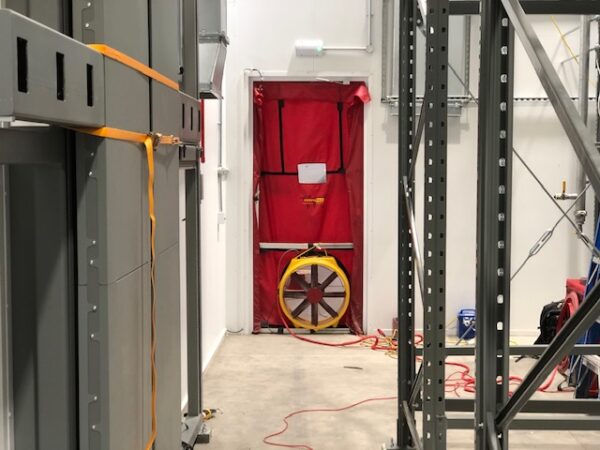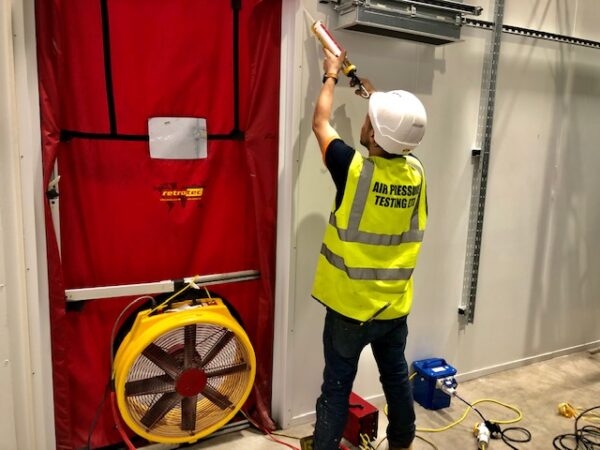Have You Failed Your Air Tightness Test?
On previous projects where our clients buildings have failed the air tightness test, we have used combined air tightness testing and smoke surveys to record the air leakage paths. On some projects, we have encountered very ‘leaky’ dwellings and commercial buildings, that achieved air leakage rates in excess of 40m3/h/m2 – or 8 times the usual air permeability requirements of Building Regulations Part L. By utilising pressurised smoke surveys we have managed to quickly identify the air leakage paths for our client’s air sealing teams, which invariably ends up with a successful air test at the second attempt.
Air tightness testing and smoke surveys provide a powerful combination, as it provides an accurate and visual approach to identifying and controlling air leakage in in buildings. Our blower door equipment can be set up quickly with minimal disruption to projects, and the test and smoke survey can be carried out in a matter of minutes, meaning that you can quickly establish buildings air leakage rate, as well as producing an accurate air leakage survey report, highlighting the air leakage paths within the building envelope, to allow targeted remedial sealing works minimising time and costs.

How do you undertake an air leakage smoke survey?
Our blower door fan mounts into a door-sized housing, that can be adjusted to suit the size of the door frame.
We then set up the blower door equipment using the following procedure:
- Firstly, we temporarily install a blower door fan system (depending on building size) in a suitably placed doorway
- We then take a series of environmental measurements such as internal and external temperatures as well as barometric pressures and undertake measurements between 25-70Pa in 5Pa increments, recording the pressure differential at each step
- Finally, our technicians will calculate the total air flow required to achieve a pressure differential of 50 Pa, divided by the total building envelope area – this calculation will show leakage rate in m³/h.m² @ 50 Pa as well as the equivalent air leakage area.
- Once its been established that the building has failed the air tightness test, we then pressurise the building (blows air into) to around 60 pascals of pressure, this forces air to flow through the air leakage paths throughout the building fabric.
- We then turn on the smoke machine and walk around the building recording all the air leakage paths through the building envelope
- We send a detailed smoke survey report to the client to distribute to his remedial sealing team.
It usually takes 1-2 hours to complete an air leakage smoke test; however, we can attend site for a whole day if required. This allows time for operatives to seal all the necessary air leakage paths on the day of the test. If you are planning on undertaking remedial sealing works on the day of the test, your operatives will need to have the correct sealing materials, such as mastic, expanding foam, draught excluders, plasterboard, grip fill and suitable safe access to undertake the sealing works. Here is a video of a typical smoke survey to a dwelling.
If some of the areas are difficult to reach such as very tall commercial buildings, we can also undertake a Thermography survey. This is performed using an infra-red camera to identify hot and cold spots on the surface of the building; this requires a temperature variation and is often done at night.

Why is useful to know the Equivalent Leakage Area (ELA)
once we have undertaken the air tightness test, our software not only works out the air leakage rate, it also works out the equivalent leakage area (ELA) which can be extremely useful. For instance, if our the building fails the test at 20m3/hr/m2 and you need to achieve a figure of 20m3/hr/m2, you know it is approx. 4 times over the air permeability target.
Our computer software then converts the pressure drop to an equivalent leakage area (ELA), which is the overall size of a single hole in the building fabric, so say the overall equivalent air leakage area (ELA) is one metre square (1m x 1m) you know that you will need to reduce the ELA to approx. 0.25m2 (500mm x 500mm) to attain a pass.
The equivalent leakage area (ELA) is very useful for our engineers and clients to understand the cumulative effect of the many small leaks – such as leakage along a skirting board – that are present within a typical building as they may add up to the equivalent of an open door or window on the building. for instance if you have one hundred linear metres of skirting board with a 5mm gap, you will end up with an approx. air leakage area of half a metre square, more than enough to fail a large house, especially if its got to get down to an air leakage rate of 3m3/h/m2.
The types of Smoke machines used on air leakage surveys
We usually use 3 different types of smoke machines for our air leakage surveys. We have a smaller handheld smoke machine for standard size houses. Our middle size smoke machine uses pressurised smoke canisters, which is extremely useful for large houses and smaller commercial buildings. Our large smoke machine is used on large commercial buildings.
So, to recap, we use the different size smoke machines on the following buildings:
- Small smoke machine – houses, flats, and laboratories
- Mid-size smoke machine – large houses and small commercial buildings
- Large smoke machine – large commercial buildings
In all instances, we always use our smoke machines with our blower door systems to accurately identify the air leakage paths in buildings. Without the inclusion of a blower door system to pressurise the entire building, you will only see small amounts of ‘wispy’ smoke drifting around, which makes it very difficult to accurately identify the air leakage paths.
Common Air Leakage Paths
- Poorly installed windows and doors which do not close tightly
- Defective windows and doors with missing seals
- The gap at the wall/skirting board junction.
- Perimeter and internal wall/floor junctions.
- Gaps around service penetrations (such as water and electrical) through floor and walls
- Pathways through ceiling voids into masonry cavity walls
- Pathways through eaves in cavities
- Gaps around windowsills and door reveals
- Gaps around bathroom and WC services
- Gaps around kitchen and utility services.
- Gaps between dry lining and ceilings
- Unsealed chimneys
- Gaps around electrical and IT fittings
- Gaps around ceiling loft hatches
- Ventilation penetrations through the walls, ceiling, and roof
- Poorly installed extractor fans to kitchens, utility, and bathrooms
We can help you pass you air tightness test
At APT Sound Testing we have large amount of experience in understanding the requirements of Approved Document L, along with extensive experience of carrying out thousands of successful air tightness tests on a wide range of developments across London and the UK.
In order to achieve the required air tightness target and to avoid the risk of a failed air tightness test, we strongly recommend that early consideration is given to the design of the air leakage line within your project. By working with our customers at the design and construction stages we provide advice and guidance on the most feasible ways to avoid air leakage and attain compliance for the air tightness test. Please download our air tightness checklist for more information on how to prepare your building for the air tightness test.
At APT Sound Testing, we are happy to provide you with general air leakage design advice for your building envelope and onsite guidance. Upon completion of your project, we provide Nationwide UKAS Accredited Tightness Testing for domestic and commercial buildings to help you demonstrate Building Regulation Part L Compliance.
To find out more about our air tightness testing service or if you wish to discuss your project please contact us on 01525 303905 or email us at info@aptoundtesting.co.uk